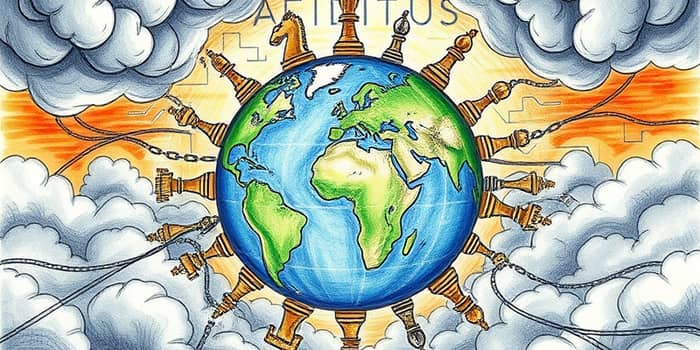In 2025, the world faces a complex tapestry of overlapping challenges, from state rivalries to technological disruptions. Economic forecasts are shaded by protectionist moves and security priorities that often override traditional trade considerations.
This era of geoeconomic contestation reshapes global ties and redefines national priorities. As nations adopt a protectionist stance and tariff hikes, trade flows invert decades of integration, prompting companies and governments to reassess long-standing alliances.
Global Macro Trends
At the macro level, four dominant forces set the stage for heightened uncertainty. First, the fragmentation of globalization accelerates as the United States considers tariffs of up to 60% on Chinese imports and 20% on other partners, triggering potential retaliatory measures. Second, the concept of a "geopolitical recession" emerges: economic cooperation takes a back seat to national security, while unilateral policy actions multiply.
Third, advanced economies grapple with inflation persistently above pre-pandemic levels, keeping sovereign bond yields elevated and tightening financial conditions. Fourth, Asia-Pacific remains the long-term growth engine, with governments investing heavily in critical minerals and supply-chain resilience to counter global headwinds.
Underlying each of these trends is the rise of strategic competition in sectors such as biotech, energy, and especially artificial intelligence. With minimal regulatory oversight, AI becomes both an innovation driver and a potential vector for espionage and social manipulation.
Top Geopolitical Risks
Survey data and expert assessments converge on a set of risks that will define 2025. Armed conflict leads the pack, fueled by ongoing wars and flashpoints that could escalate. Simultaneously, state-sponsored cyber operations and hybrid tactics threaten critical infrastructure at unprecedented scale.
- State-based Armed Conflict: Ranked the top risk by 23% of experts, driven by Russia-Ukraine, Israel-Hamas, and emerging flashpoints.
- US-China Breakdown: Economic decoupling and tariff wars accelerate fragmentation and provoke retaliation.
- Russia Subverting Global Order: Hybrid threats, disinformation campaigns, and institutional undermining intensify.
- AI & Cyber Warfare Surge: Targeted cyber attacks in critical sectors have risen by 300%, with few regulatory guardrails.
- Misinformation & Disinformation Waves: Projected as the #1 risk by 2027, eroding public trust and democratic resilience.
- Terrorism Persisting Threat: Extremist groups exploit regional instability, particularly in areas weakened by proxy conflicts.
- Supply Chain Vulnerability: The push for fragmented supply chains and friend-shoring reshapes trade patterns amid strategic competition for resources.
Regional and Sectoral Impacts
While global trends set the context, each region experiences the risk landscape differently. Europe struggles with high energy prices, modest growth forecasts, and fiscal constraints that hamper rapid response. North America faces policy volatility that ripples through NAFTA-area trade, as shifts in U.S. tariffs and Mexican constitutional reforms create uncertainty.
Asia-Pacific stands out with robust growth but also heightened competition over critical minerals and technology standards. Governments in Japan, South Korea, and Australia are bolstering supply chain security to guard against disruptions. In the Middle East, proxy conflicts and domestic fragility combine to maintain a persistent threat environment.
This table underscores the varied economic trajectories and pressures that define each major region’s risk profile. Sectorally, biotech emerges as a new frontier of strategic competition, with control over intellectual property and regulatory regimes becoming heavily politicized.
Meanwhile, the energy transition introduces its own set of security challenges, from critical mineral shortages to grid vulnerabilities. Across industries, firms must navigate an environment of unchecked AI proliferation and data risks, where cyber resilience can determine competitive advantage or catastrophic loss.
Strategic Recommendations
To thrive in this volatile landscape, organizations and governments must adopt proactive measures that build resilience and leverage risk as an asset rather than a liability.
- Shift supply chains toward geographic proximity with friend-shoring partnerships to reduce exposure to sudden policy shifts.
- Invest in robust cybersecurity frameworks and continuous threat monitoring to counter surging cyber warfare threats.
- Enhance compliance, data governance, and legal agility to respond swiftly to evolving regulations.
- Diversify capital flows and financing sources to mitigate cross-border investment risks.
- Foster an adaptive corporate culture that embraces change and empowers decentralized decision-making.
Looking Ahead: The Next Frontier
As we move beyond 2025, expect further fragmentation of the global order into a "G-Zero" environment marked by competing blocs and absent global governance. Technological advances in AI, biotech, and quantum computing will outpace regulatory frameworks, creating fertile ground for hybrid threats and large-scale information manipulation.
Geoeconomic contestation will continue to drive countries toward unilateral policy actions, trade barriers, and strategic alliances defined more by distrust than shared norms. At the same time, ungoverned spaces—failing states, crisis zones, and digital hinterlands—will become staging grounds for non-state actors and shadow conflicts.
To navigate this unpredictable future, stakeholders must embrace continuous scenario planning, strengthen cross-sector cooperation, and invest in capabilities that anticipate emerging threats. By turning risk management into a strategic asset, businesses and governments can not only preserve stability but also uncover new opportunities for innovation and growth in an uncertain world.
References
- https://www.lazard.com/research-insights/top-geopolitical-trends-in-2025/
- https://www.spglobal.com/en/research-insights/market-insights/geopolitical-risk
- https://www.weforum.org/publications/global-risks-report-2025/digest/
- https://www.eurasiagroup.net/issues/top-risks-2025
- https://kongsbergdigital.com/blog/navigating-geopolitical-risk-in-turbulent-times
- https://www.blackrock.com/corporate/insights/blackrock-investment-institute/interactive-charts/geopolitical-risk-dashboard
- https://kpmg.com/xx/en/our-insights/risk-and-regulation/top-risks-forecast-2025.html
- https://www.ey.com/en_us/insights/geostrategy/2025-geostrategic-outlook










